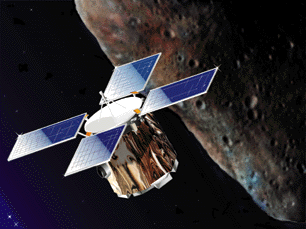
The Near Earth Asteroid Rendezvous (NEAR) mission was the first launch in the
Discovery Program, a NASA initiative for small planetary missions with a maximum
3-year development cycle and a cost capped at $150 million for construction,
launch, and 30 days of operation. The NEAR mission was managed for NASA by the
Johns Hopkins University
Applied Physics Laboratory , Laurel, Maryland.
As the first spacecraft to orbit an asteroid, the NEAR mission promised to
answer fundamental questions about the nature and origin of near-Earth objects,
such as the numerous asteroids and comets in the vicinity of Earth's orbit.
The NEAR spacecraft touched down on Eros in February, 2001, returning the highest resolution pictures of an asteroid's surface.
The X-ray/gamma-ray spectrometer (XGRS), one of five major facility
instruments on the NEAR spacecraft, was the primary experiment for determining
surface/near-surface elemental composition of the near-Earth asteroid 433 Eros.
XGRS measurements would be fundamental to solving such mysteries as the source of
meteorites and their relationship to asteroids.
Although XGRS was intended primarily for these compositional studies, it
has also been used to make measurements of the diffuse X-ray and gamma-ray
background during the cruise phase of the mission as part of the instrument's
background calibration studies.
| XGRS General |
Mass: 26.90 kg |
|---|
| Power: 24 W (including DPU) |
|
X-ray Fluorescence Spectrometer |
Detectors: 3 gas-filled proportional counters;
25-cm2 active aperture area;
25-mm beryllium window, uniformity ~ ±5% ;
Beryllium liner and window support
|
|---|
| Energy range: 1 to 10 keV; Rise-time discrimination to reduce
background contamination |
| Energy resolution: <1 keV FWHM @ 5.95 keV |
| In-flight calibration sources: 55Fe |
| Counting rate: Full performance up to 10 kHz |
| X-Ray Solar Monitors |
Gas-filled proportional counter with graded shield (resolution
<1 keV FWHM @5.95 keV) and solid-state high-resolution solar monitor
(resolution <600 eV FWHM @ 5.95 keV). |
|---|
| Gamma-Ray Spectrometer |
Energy range: 0.3 to 10 MeV in 10-keV channels |
|---|
| Prime detector: 2.5 x 7.5 cm NaI (Tl) scintillator;
8.5% FWHM min resolution @ 662 keV FOV ~ 60° |
| Shield detector: 8.9 x 14 cm BGO scintillator cup shield; 15% FWHM min resolution @ 662 keV |
| Counting rate: Full performance up to 10 kHz |
The X-ray fluorescence experiment used three gas-filled proportional
counters, collimated to 5 degrees, observing X-ray line emissions from the
asteroid. Balanced filters on two detectors (Al on one and Mg on the other) were
used to separate Mg, Al, and Si lines; Ca, Ti, and Fe lines are resolved. The
solar monitor used an additional gas-filled proportional counter with a pinhole
active area observing the X-ray spectrum of the Sun. A high-resolution,
solid-state solar monitor could be alternatively selected.
The gamma-ray spectrometer used a body-mounted NaI scintillator with BGO
shield. This unique design eliminated the need for both a long boom and active
cooling. This subsystem of the XGRS detected naturally radioactive elements-K,
Th, U-by their gamma rays and those of their decay chain products. In addition,
it could detect other elements-Fe, Si, O, H-by gamma rays produced by cosmic ray
interactions. The gamma rays of interest are typically between 0.2 and 10 MeV.